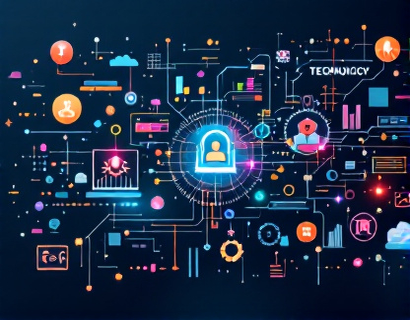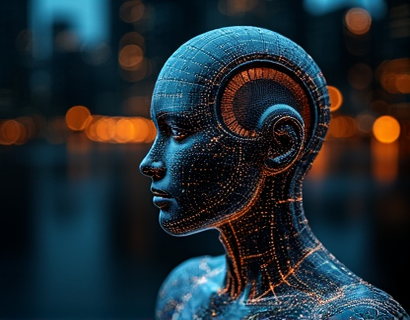Revolutionizing Digital Interactions: The Synergy of Crypto and AI
The intersection of cryptocurrency and artificial intelligence (AI) is giving rise to a new era of digital innovation, transforming the way we interact with apps and services. This convergence is not just a technological curiosity but a powerful force reshaping the digital landscape. As we delve into this topic, it's essential to understand the fundamental roles that both crypto and AI play and how their integration is leading to groundbreaking solutions.
Understanding Cryptocurrency and AI
Cryptocurrency, often seen as digital or virtual currency, operates on blockchain technology, a decentralized ledger that ensures transparency, security, and immutability. Beyond mere digital money, cryptocurrencies like Bitcoin, Ethereum, and others serve as a medium for decentralized applications (dApps) and smart contracts, which automate and enforce agreements without intermediaries.
Artificial intelligence, on the other hand, encompasses a range of technologies designed to simulate human intelligence processes such as learning, reasoning, and self-correction. AI algorithms can analyze vast amounts of data, recognize patterns, and make decisions with minimal human intervention. The combination of these two technologies is unlocking new possibilities in various sectors, particularly in enhancing digital experiences.
The Convergence of Crypto and AI
The synergy between cryptocurrency and AI is particularly potent in the realm of digital services. By leveraging the security and decentralization of crypto, combined with the intelligence and adaptability of AI, developers can create more secure, efficient, and user-friendly applications. This convergence is leading to innovative solutions that not only improve existing services but also pave the way for entirely new categories of digital experiences.
Enhanced Security through Crypto and AI
One of the most significant benefits of combining crypto and AI is the enhancement of security measures. Traditional systems often rely on centralized servers, making them vulnerable to hacking and data breaches. By using blockchain, data is distributed across a network of nodes, reducing the risk of a single point of failure. AI can further bolster security by detecting and mitigating threats in real-time, identifying anomalies and potential attacks before they occur.
For instance, AI-driven security systems can monitor network activity continuously, learning from past incidents to improve their detection algorithms. This proactive approach ensures that any suspicious activity is promptly addressed, maintaining the integrity and safety of user data. In the context of cryptocurrency, this means more secure transactions and a higher level of trust in decentralized platforms.
Personalized User Experiences with AI
AI's ability to analyze vast datasets and derive meaningful insights makes it an ideal tool for personalization. In the digital space, this translates to tailored experiences that cater to individual user preferences and behaviors. When combined with the transparency and user control offered by cryptocurrency, the potential for personalized services becomes even more compelling.
Imagine a digital platform that uses AI to analyze your interactions and preferences, then rewards you with a cryptocurrency for engaging with content or completing tasks. This not only enhances the user experience but also creates a more engaging and motivating environment. The data collected through these interactions can be used to refine the AI algorithms, creating a virtuous cycle of improvement and personalization.
Decentralized Applications and Smart Contracts
Decentralized applications (dApps) are a prime example of how crypto and AI can transform digital services. Unlike traditional applications hosted on centralized servers, dApps run on blockchain networks, ensuring decentralization and transparency. AI can enhance dApps by providing intelligent functionalities, such as predictive analytics, natural language processing, and automated decision-making.
Smart contracts, self-executing contracts with the terms directly written into code, can also benefit from AI integration. AI can help in drafting more efficient and fair smart contracts by analyzing historical data and predicting outcomes. This reduces the risk of errors and ensures that the terms of the contract are adhered to automatically and reliably.
Use Cases of Crypto and AI in Digital Services
The potential applications of crypto and AI in digital services are vast and varied. Here are some key areas where this synergy is making a significant impact:
Financial Services
In the financial sector, the combination of crypto and AI is revolutionizing how we manage money and conduct transactions. Decentralized finance (DeFi) platforms use blockchain to offer lending, borrowing, and trading services without intermediaries. AI can optimize these processes by predicting market trends, managing risks, and automating trades. This results in more efficient and accessible financial services for users worldwide.
Healthcare
In healthcare, AI can analyze medical data to provide personalized treatment recommendations, while blockchain ensures the secure and privacy-preserving storage and sharing of patient records. Cryptocurrency can facilitate seamless and secure transactions for healthcare services, insurance claims, and drug supply chains. This integration not only improves patient care but also enhances the overall efficiency of healthcare systems.
Supply Chain Management
Supply chain management benefits greatly from the transparency and traceability offered by blockchain. AI can optimize supply chain operations by predicting demand, managing inventory, and identifying bottlenecks. Cryptocurrency can streamline payments and transactions within the supply chain, reducing costs and increasing speed. Together, these technologies ensure a more reliable and efficient supply chain.
Content Creation and Distribution
The content creation and distribution industry is another area where crypto and AI are making waves. Creators can use blockchain to monetize their work directly, without intermediaries, and receive fair compensation. AI can help in content recommendation systems, ensuring that users discover content that aligns with their interests. Cryptocurrency can serve as a medium for transactions, providing a transparent and secure way to handle payments and royalties.
Challenges and Considerations
While the potential of crypto and AI in digital services is immense, there are several challenges and considerations that need to be addressed. Regulatory frameworks are still evolving, and the lack of clear guidelines can pose risks for developers and users. Ensuring compliance and navigating the legal landscape is crucial for the sustainable growth of these technologies.
Another challenge is the technical complexity involved in integrating crypto and AI. Developers need a deep understanding of both domains to create robust and secure solutions. Education and training programs can help bridge this gap, fostering a community of experts who can drive innovation in this space.
Future Prospects
Looking ahead, the future of digital services powered by crypto and AI is bright. As technology continues to advance, we can expect even more sophisticated and seamless integrations. The rise of Web3, a decentralized internet built on blockchain, promises to redefine how we interact online, with crypto and AI at its core.
Moreover, the increasing adoption of 5G and IoT devices will create a wealth of data that AI can process to offer more intelligent and responsive services. The combination of these technologies will not only enhance user experiences but also open up new business models and opportunities for innovation.
In conclusion, the convergence of cryptocurrency and artificial intelligence is transforming digital experiences in profound ways. By enhancing security, personalization, and efficiency, this synergy is shaping the next generation of digital services. As we continue to explore and harness the potential of these technologies, the future of digital interaction looks more promising than ever.










































